Antinol® Latest Studies
Sorted by recent
 Filter Studies by Smart Tags
Filter Studies by Smart Tags
Bone & JointCardiovascularCase Study & ProceedingCatDogEAB 277™EfficacyExotic PetImmunologyNeuro & BehaviorOphthalmologyOralRabbitRenalRespiratoryRodentSafetySkinUTI
Smart Search
Antinol® Case Study Contest 2020

The 8 Case Studies from Antinol® Case Study Contest of 2020.
________
1st Winning Awards
1) Use of PCSO-524® and Cyclosporin for Treatment of Immune-Mediated Polyarthritis in Dogs
2) Use of PCSO-524® for Supplementary Treatment of Protein Losing Nephropathy in Animals
________
2nd Winning Awards
3) Use of PCSO-524®(Antinol®) in a Pomeranian Dog with Degenerative Mitral Valve Disease (DMVD) and Cardiac Tumor of the Left Atrium
________
3rd Winning Awards
4) Use of PCSO-524 (Antinol®) for Treatment of Chronic Pododermatitis in FIghting Cocks
5) Use of PCSO-524® with Physical Rehabilitation to Regain Mobility in Dogs after Femoral Head and Neck Excision
6) Use of PSCO-524® (Antinol®) and Casting for Treatment of Tetraparesis and Neck Pain Due to Atlantoaxial Instability and Subluxation of the 1st-2nd Cervical Vertebrae
7) Effect of One Year Treatment with PCSO-524® on Feline Dermatophytic Pseudomycetoma

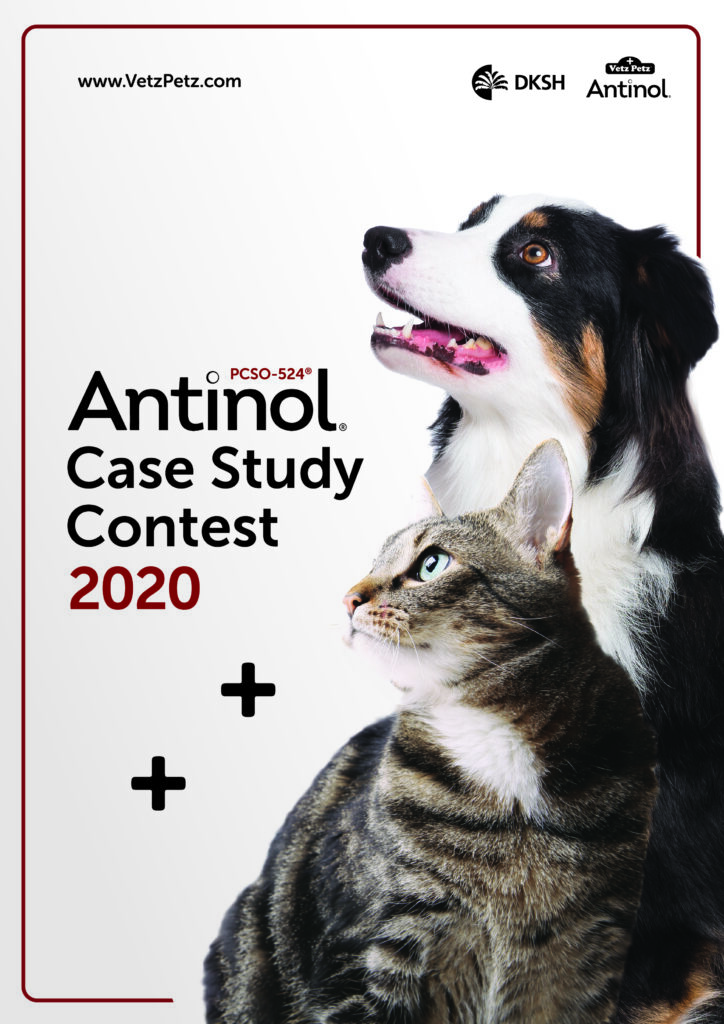

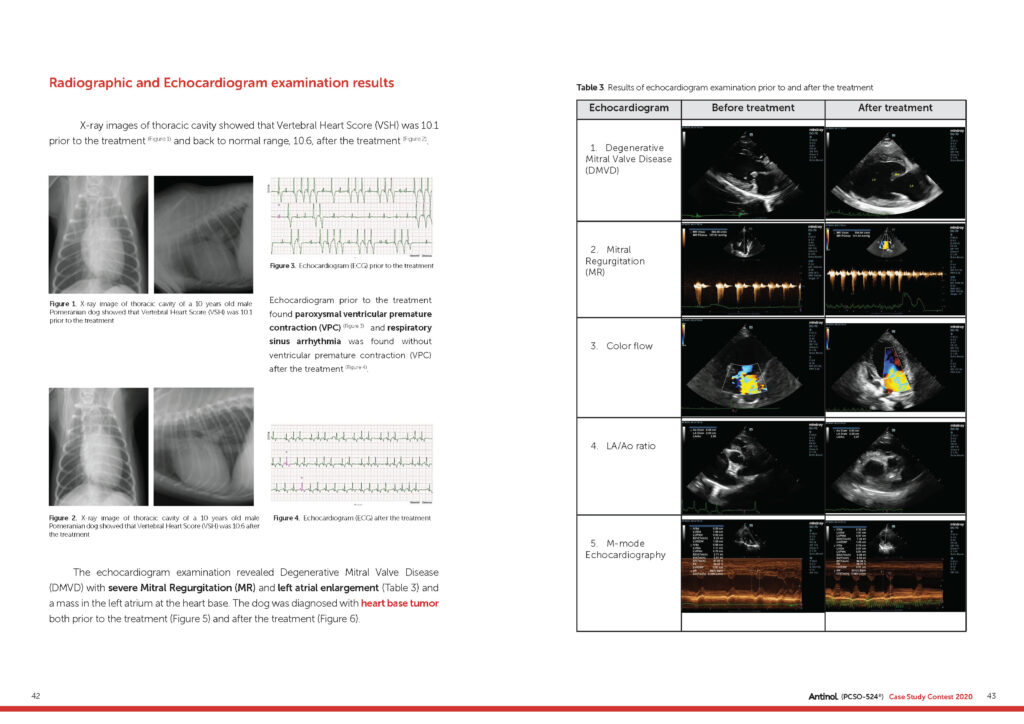
Use of PSCO-524® (Antinol®) and Casting for Treatment of Tetraparesis and Neck Pain Due to Atlantoaxial Instability and Subluxation of the 1st-2nd Cervical Vertebrae

A 7 months old male Pomeranian dog was admitted to Thong Lor animal hospital for signs of intermittent leg paresis and hyperesthesia during the past 2 weeks.
Physical examination found grade II tetraparesis, neck hyperflexion, spasm of cervical muscle, and cervical hyperesthesia.
X-ray examination showed atlantoaxial instability and dorsal subluxation of the first and second cervical vertebrae. The disease is congenital and commonly found in toy breed dogs (Itoh H. et al, ).
A cast was used to stabilize the joints for 12 weeks in conjunction with medicinal treatment including pain killer medicine, gabapentin, and 1 capsule of PSCO-524® (Antinol®) sid.
After one week of the treatment, the dog showed no sign of pain when touched but the signs of hind limb paresis still remained. The treatment was continued until the 10th week that gabapentin was terminated and no recurrence of pain was detected since then.
After 12 weeks of the treatment, the cast was removed and PSCO-524® (Antinol®) 1 capsule sid was continued and the dog did not show any progressive development of clinical signs.
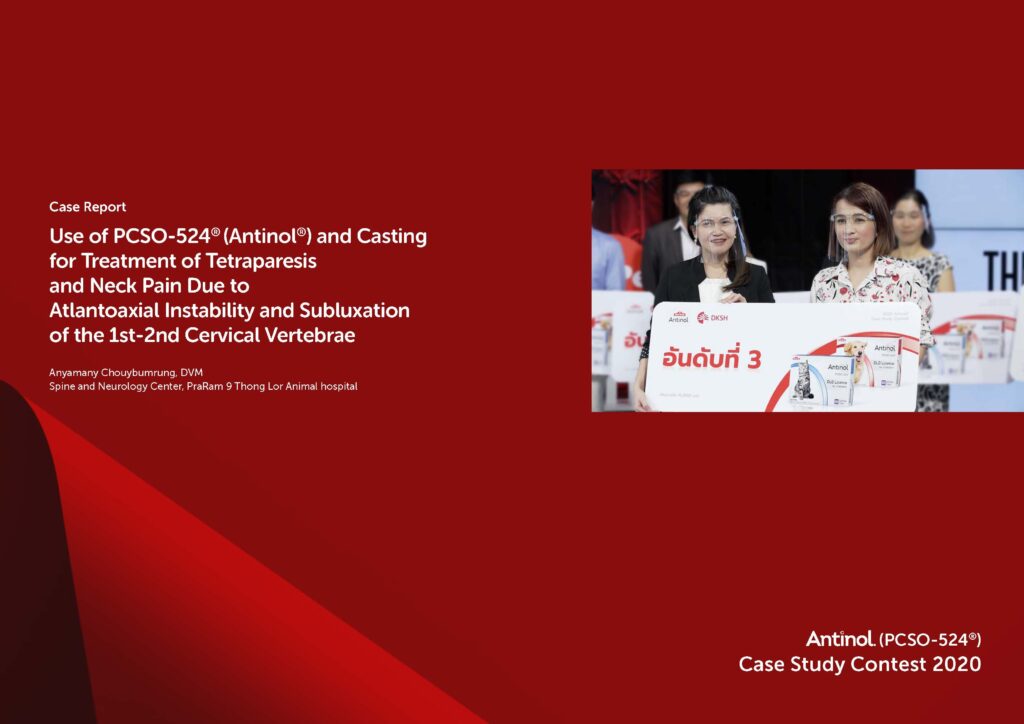
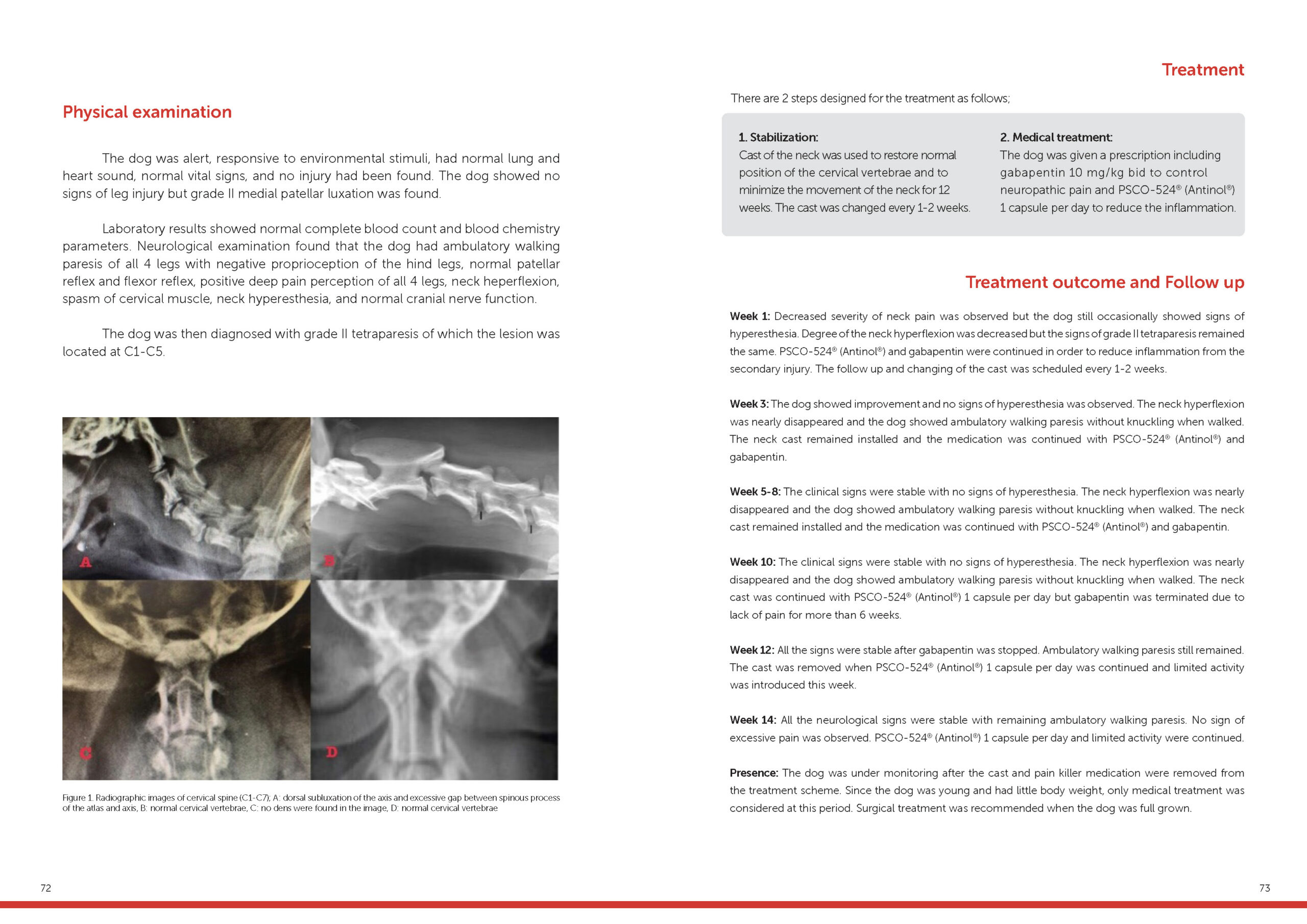
Use of PCSO-524® with Physical Rehabilitation to Regain Mobility in Dogs after Femoral Head and Neck Excision

An 8 years old Pomeranian dog showed acute non weight-bearing lameness of the right hind limb after high jumping. Preliminary examination identified pain at the right hip and radiographic images revealed right hip luxation.
Femoral head and neck excision was performed for the surgical treatment.
Multimodal treatment scheme deployed after the surgery consisted of neutraceutical PCSO-524® and physical rehabilitation using laser class 4, exercise such as Cavaletti exercise, balanced board, walking on treadmill, and hydrotherapy including walking under water and swimming.
Evaluation of the treatment during follow-up showed decreased pain score and severity of lameness, which was consistent with the owner’s report that described improvement of weight- bearing of the right hind limb and the quality of life.
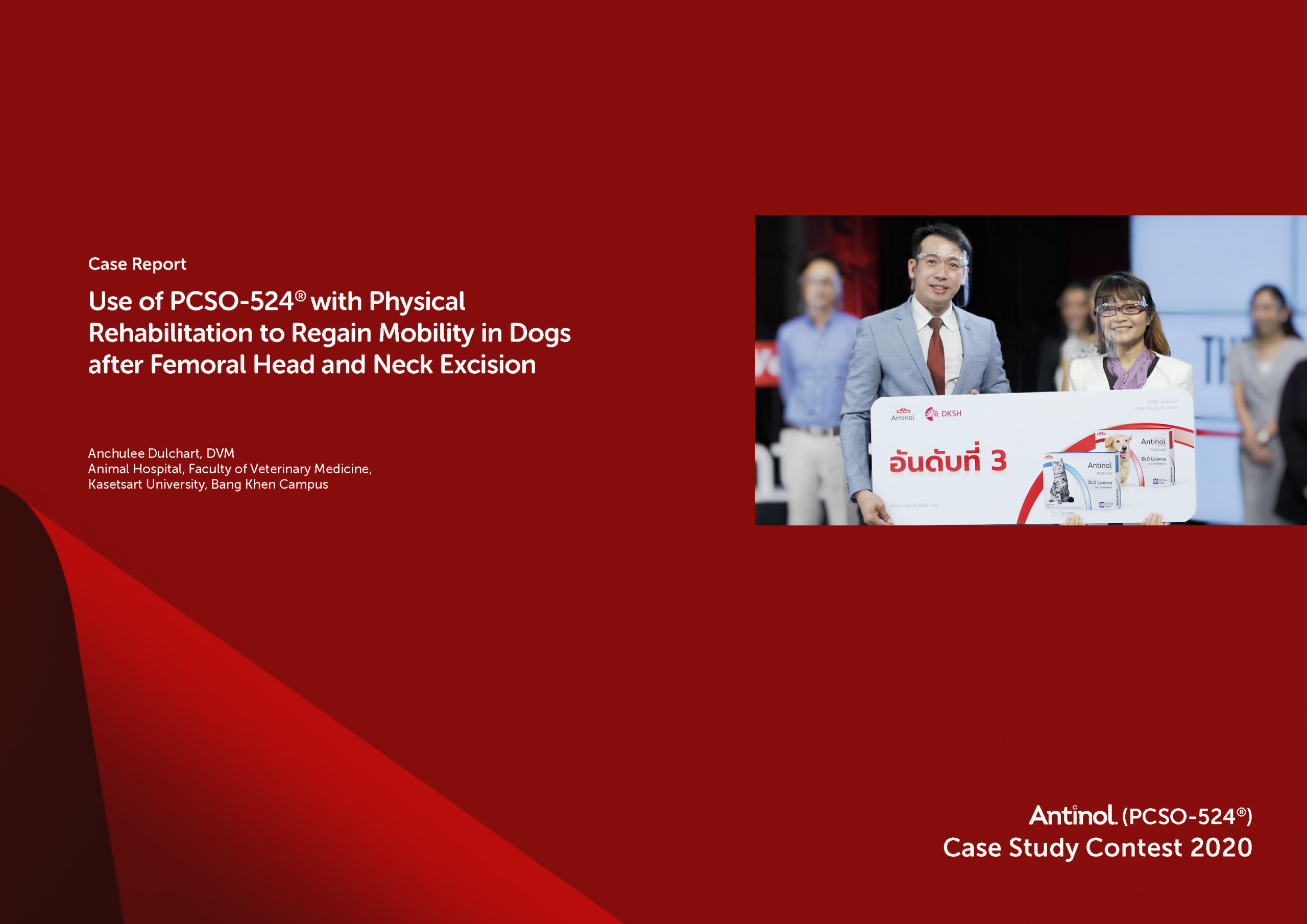
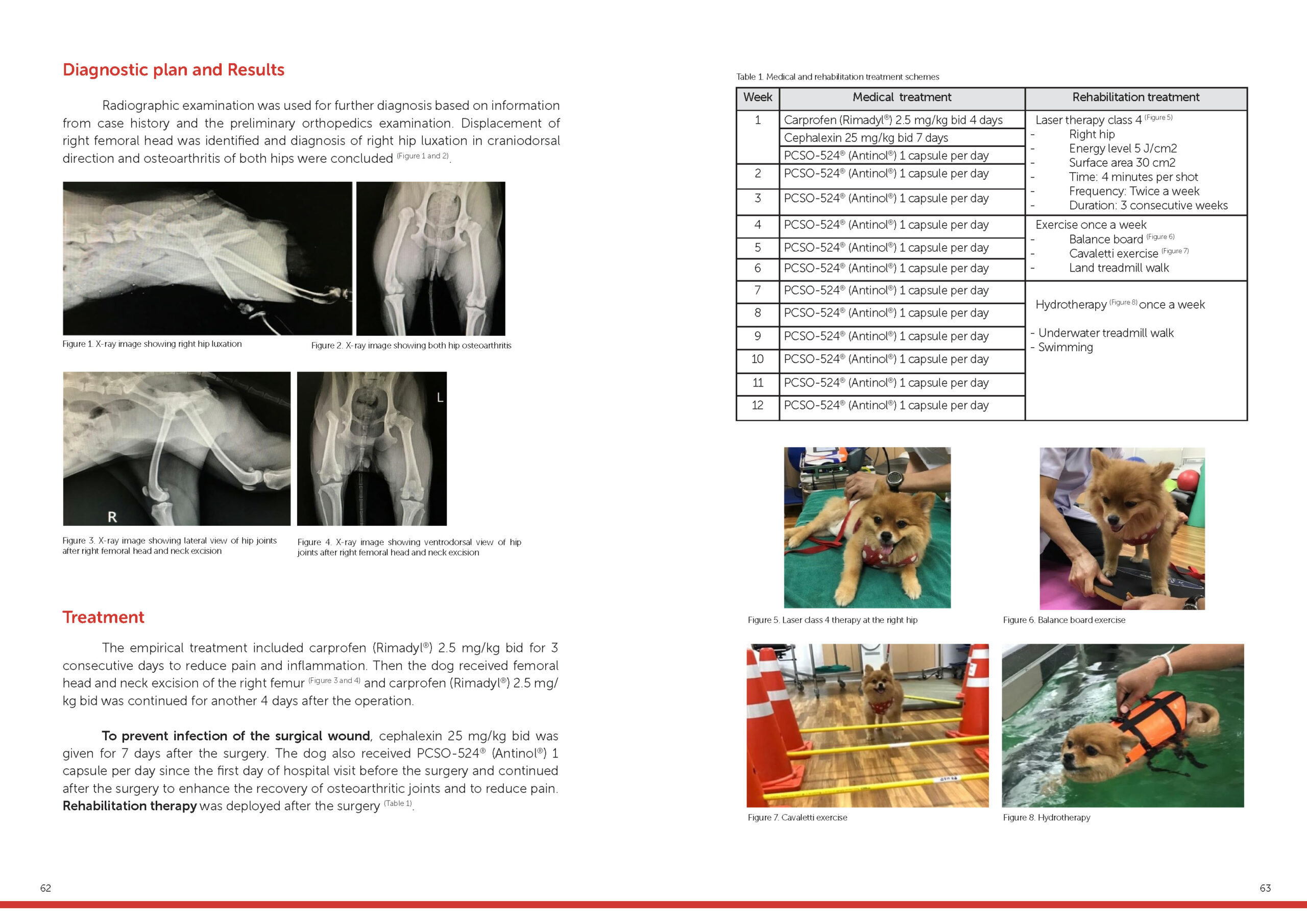
Use of PCSO-524® and Cyclosporin for Treatment of Immune-Mediated Polyarthritis in Dogs

An 8 years old Chihuahua dog was admitted to the Small Animal Hospital at Chulalongkorn University due to signs of depression, lethargy, lameness and joint effusion. Hematological examination and test of synovial fluid indicated Immune-Mediated Polyarthritis (IMPA).
Prednisolone, Gabapentin and Amoxillin-clavulanic acid were prescribed for the treatment. Abnormally increase of ALT, ALK and AST enzyme was observed 1 week later, therefore, the treatment was changed to Cyclosporin, Gabapetin, and PCSO-524®. The clinical signs continued to improve after the adjustment of prescription and Cyclosporin and Gabapetin were terminated after 3 and 4 months, respectively.
A follow-up examination at 4 months later showed no signs of lameness and joint effusion and no adverse effects caused by the long-term use of PCSO-524®.
The success of IMPA treatment is a result of rapid diagnosis and appropriate treatment protocol. Follow-up for treatment evaluation is necessary during the treatment course in order to reduce the impact on health and minimize the medication dosage without risk of causing adverse effects or recurrence of the disease.

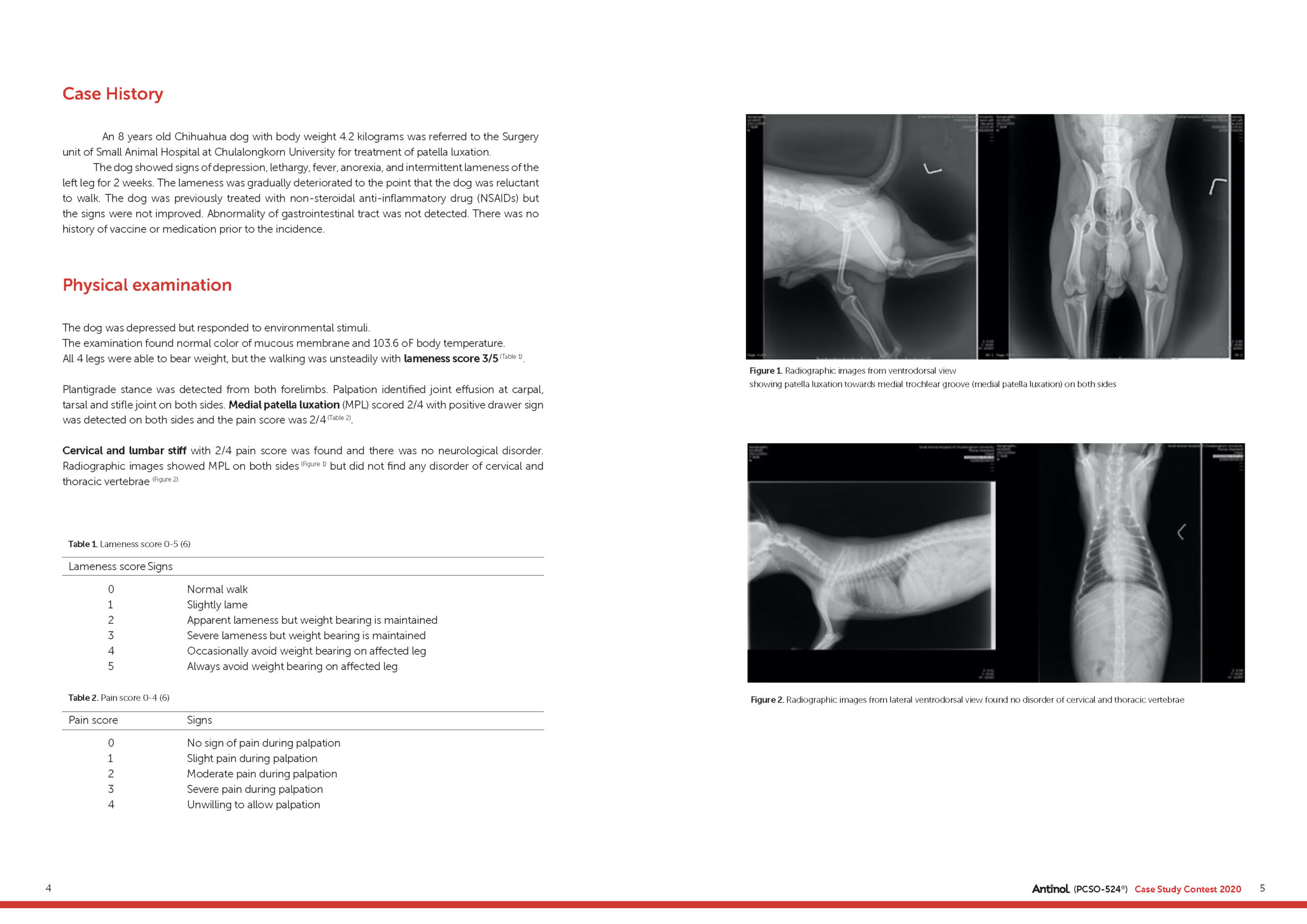
Use of PCSO-524® for Control of Inflammation Caused by Iris Tumorand Uveitis in Cats with Lymphoma and Chronic Kidney Disease

A neutered male Domestic Shorthair cat aged 8 years was infected with FIV and diagnosed with nasal submucosa-T-cell lymphoma that was positive to CD3.
Four months later, tumor of iris and uveitis were found in the left eye. Treatment of inflammation of the left eye included prednisolone acetate 1% eye drop (lnf-oph® 1 %, Seng Thai company; Thailand) qid, doxycycline (Siadocin®, Siam Bheasach; Thailand) PO at the dose 10 mg/kg/day, prednisolone (Prednisolone GPO; Thailand) PO0.36 mg/kg bid.
Two weeks later, the size of tumor remained constant, the inflammation degree was reduced but creatinine level was increased. Administration of oral prednisolone, not the eye drop, was then terminated. Uveitis of the right eye was diagnosed and also fibrin in the anterior chamber and tumor of the iris were found in the right eye. Prednisolone acetate 1% eye drop was prescribed for both eyes.
The inflammation of both eyes still existed after 1 month of the prednisolone treatment. Green Lipped mussel extract, PCSO-524® (VetzPetz Antinol®, DKSH, Thailand), 1 capsule per day was then prescribed as an alternative of steroidal medication for control of inflammation, together with the prednisolone acetate 1 % eye drop in both eyes.
After 30 days of the start of PCSO-524® treatment, the tumor of iris disappeared and the severity of uveitis was reduced in both eyes.
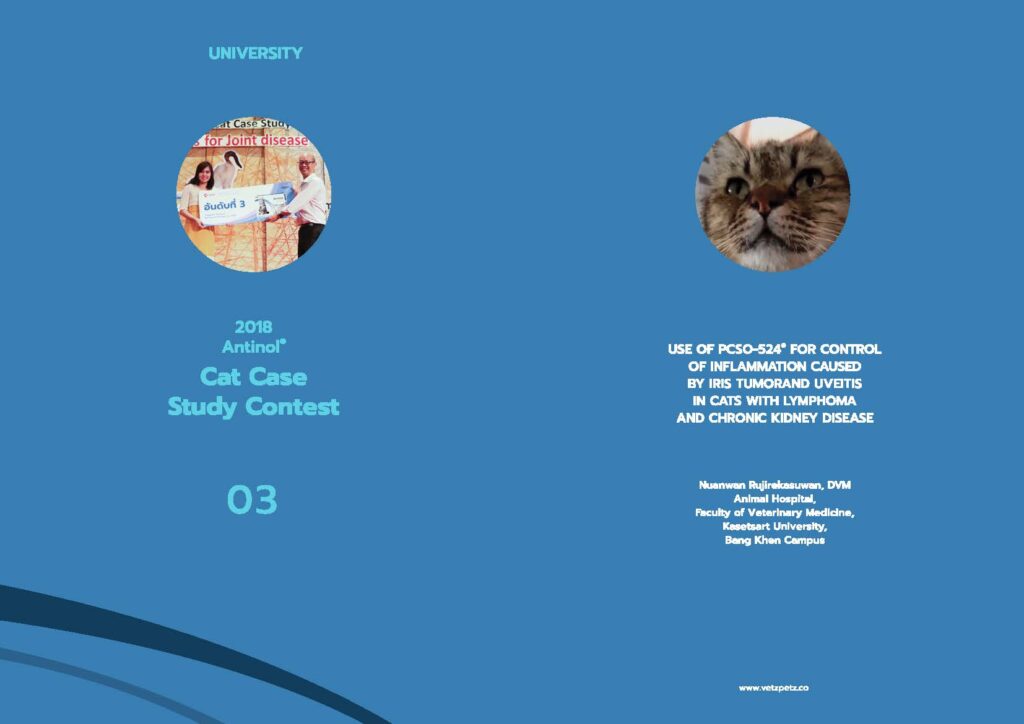

Nutraceutical Treatment of Feline Fhne and Hip Dysplasia in an 8-Month Old Cat

A Persian male cat was diagnosed with right hip luxation and left hip injury. While waiting for surgical treatment, the cat was treated with NSAIDs to control pain and inflammation.
After the operation on the right femoral head (right FHNE), the cat received antibiotics and NSAIDs for 10 and 3 consecutive days, respectively. Two weeks after the operation, the lameness and pain of the right hip, as observed from palpation, still remained, but the cat began to bear partial weight.
PCSO-524® was then prescribed and the gait analysis was performed to measure the angle of joint movement.
The monitoring showed increased angle of joint movement and decreased lameness score. This was consistent with the owner report that described less hiding behavior of the cat and improved high jump performance and better quality of life.
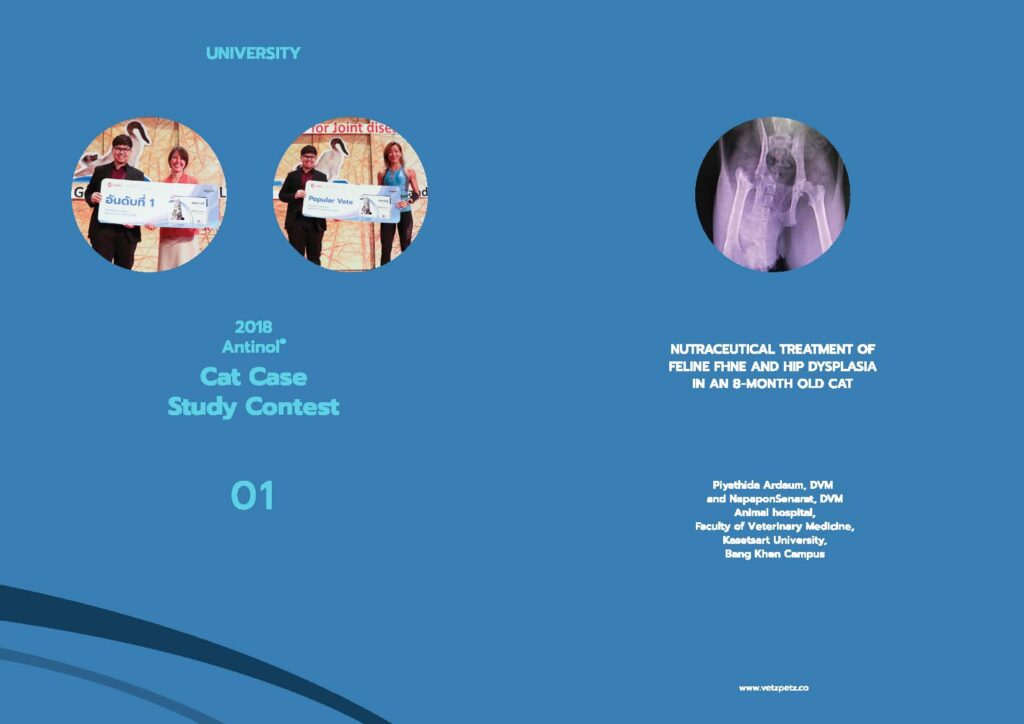
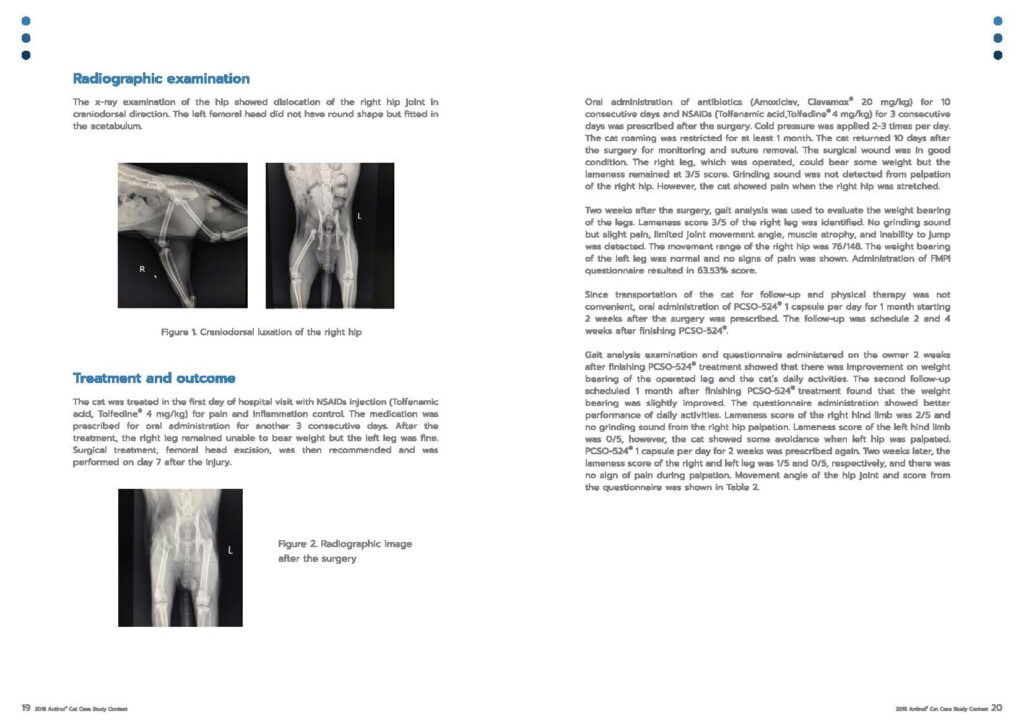
Treatment of Severe Hind Limb Paresis and Posterior Paresis Caused by Traumatic Myelopathy in Cats Using PSCO-524® (Antinol®) and Physical Therapy

A 2 years old domestic short hair cat weighted 3.55 kilograms was referred to Kasetsart University Veterinary Hospital for severe hind limb paresis with loss of sensory function. The onset of symptoms was observed a week ago after the cat returned from missing. Radiographic examination did not show any vertebral disorders. Magnetic Resonance Imaging (MRI) examination found accumulation of fluid in spinal cord at T10-T12 level, which indicated spinal cord injury. Traumatic myelopathy was diagnosed.
The paresis was grade 5 so PSCO-524® (Antinol®) 1 capsule per day was prescribed. After a week of the treatment, the cat was able to control urination and voluntary motor function of the hind limbs.
However, the sensory system malfunction remained. Spinal walk, walking with the hind limbs when sensation loss was observed after physical therapy was concurrently provided for 3 weeks.
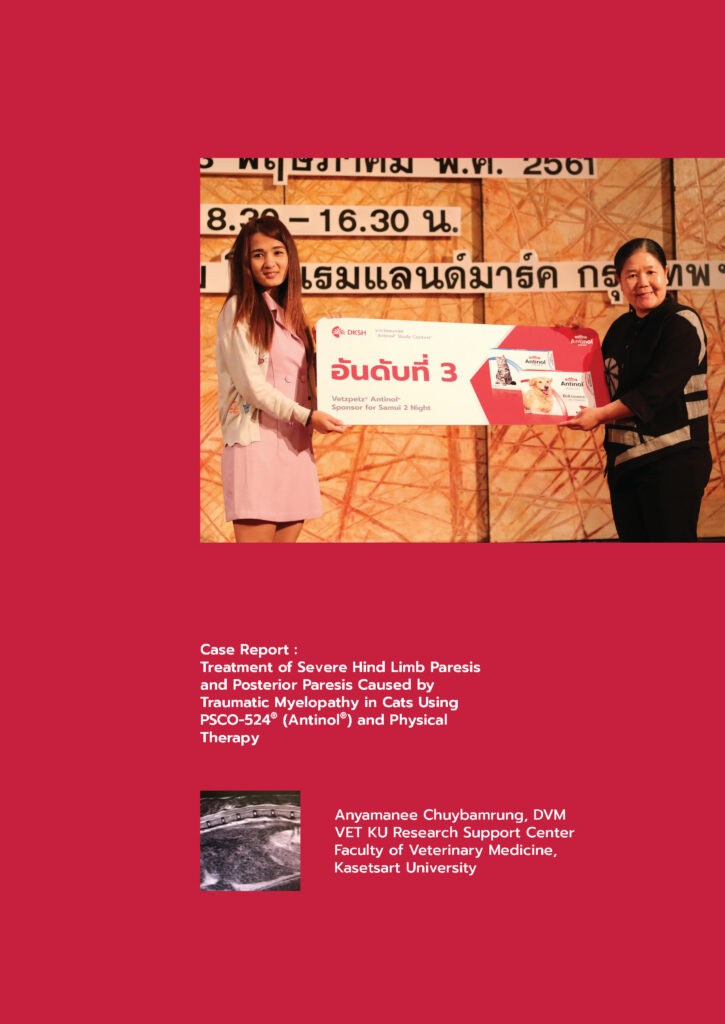
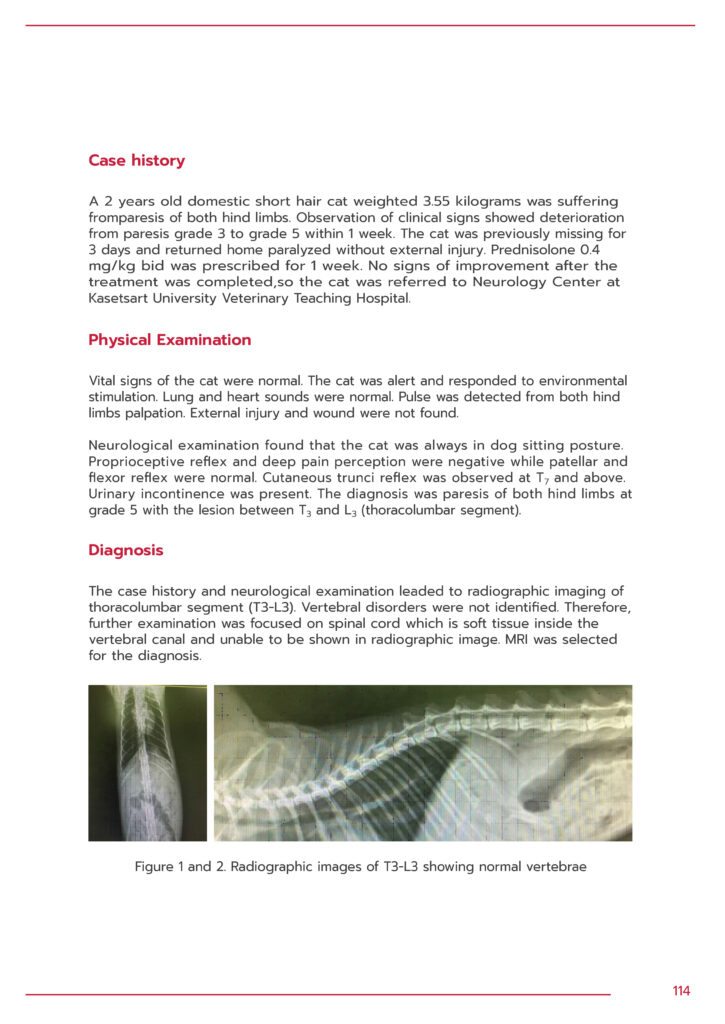
Efficacy of PCSO-524® and prednisolone combination treatment for neck pain in Chihuahua dog with Chiari-like malformation and syringomyelia

A 18-month-old male intact chihuahua presented with recurrent neck pain within 3 months after stop using prednisolone.
Upon physical and neurological examination, dog displayed pain and neck stiffness without neurological deficits. Radiographic findings of cervical spine was normal.
The dog was treated with prednisolone to relieve pain and inflammation and showed improvement of clinical signs. However, the recurrence occurred in 7 months with more severity. Magnetic resonance
imaging (MRI) demonstrated Chiari-like malformation and syringomyelia at C2-C4 and C7-T1 region.
PCSO-524® (VetzPetz Antinol®) was administered in combination with prednisolone and gabapentin. The clinical signs improved in 2 weeks so prednisolone was gradually reduced until discontinued but dose of PCSO-524® remained constantly. The dog was able to recover from neck pain and continued life activities as normal.
Long-term supplement of PCSO-524® (VetzPetz Antinol®) was effective for reducing inflammation of spinal cord in dog suffered from neck pain caused by syringomyelia.


The Trial Treatment of Feline Osteoarthritis in an Eleven-Year-Old Cat

A domestic short hair cat aged 11 years was taken to the hospital due to shaking and weakened hind legs. The cat could not perform high jump for 1 month.
Preliminary diagnosis included early stage of osteoarthritis of left hip and capsulitis.
Pain killers, NSAIDs and gabapentin, were administered but the response was not satisfied. Therefore, multimodal treatment program was initiated. Physical therapy using electrical stimulation and laser beam class 4 in conjunction with PCSO-524® were used. Measurement of joint movement angle (active range of motion; active ROM) in 2 dimensions using Kinovea program was conducted for follow up.
The study found increased active ROM and decreased lameness score after the treatment.
The owner described that the cat showed less isolation behavior and was able to perform vertical jump again. Overall quality of the cat’s life was improved.
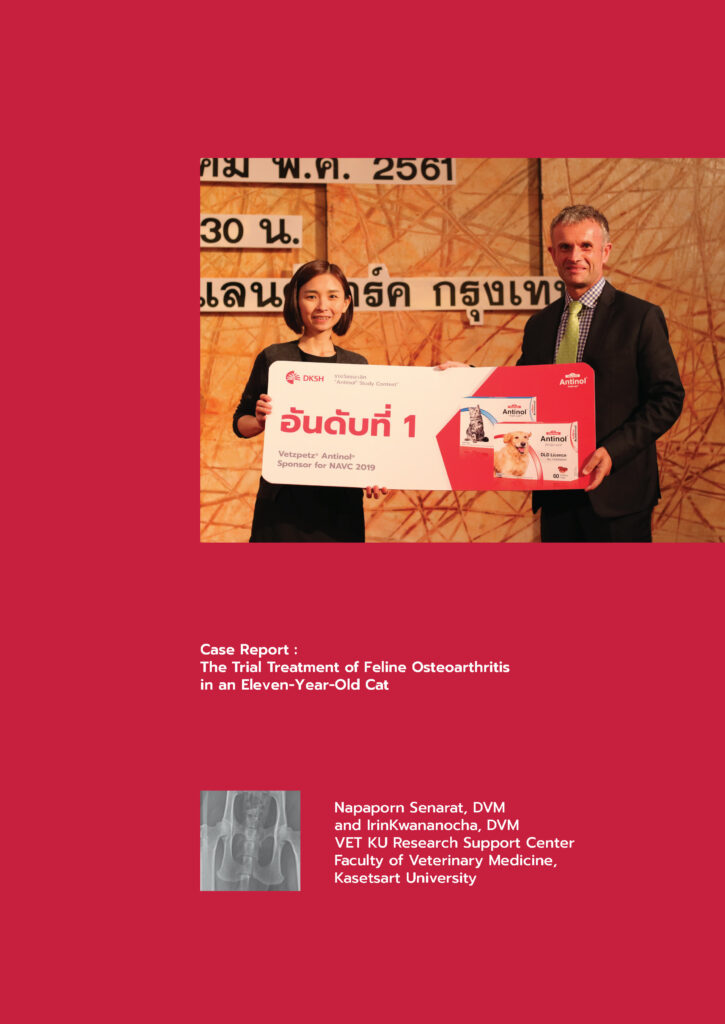

The Treatment of Medial Coronoid Disease in a Seven Months Old Labrador Retriever

Labrador retriever dog aged 7 months with history of right forelimb pain for 1 month was diagnosed as Medial Coronoid Disease (MCD) on both sides.
Radiographic and Computed Tomography (CT) examinations found subtrochlear sclerosis on left elbow. Arthrotomy was operated on the dog using subtotal coronoid ostectomy technique on the medial side of both elbows. Long-term treatment included physical rehabilitation, and nutrition therapy including administration of PCSO-524® and glucosamine/chondroitin sulfate. The dog was followed-up for 6 months for orthopedic examination and assessment by force plate gait analysis.
Two months after the operation, right forelimb could bear body weight, however left forelimb was still lame with lameness score of 1/4. Comparison of radiographic image showed that the left and right elbow was affected from moderate and mild osteoarthritis, respectively. Treatment success for MCD depends on early and accurate detection of the disease and appropriate treatment plan.
Multimodal plan consisting of surgical treatment, medication, nutrition therapy and physical rehabilitation, is proposed.
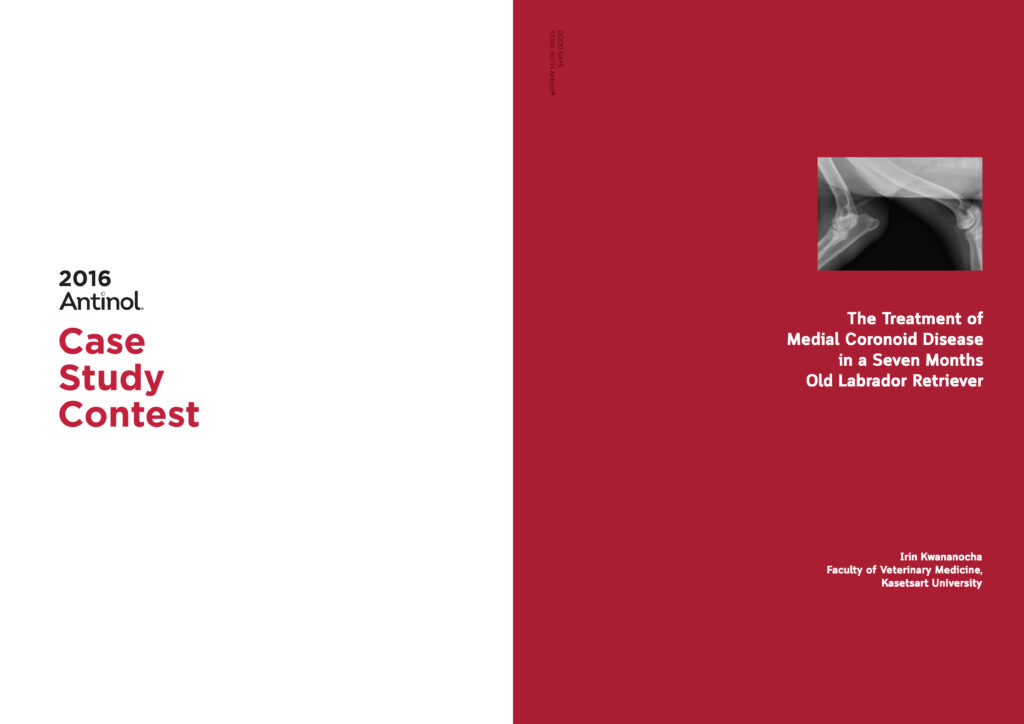

Updated Study Topics
New researches and publications related to PCSO-524® and its result in clnical test submitted by veterinarians on the global conferences every year and the data keeps growing with more studies conducted


 Authors:
Authors: